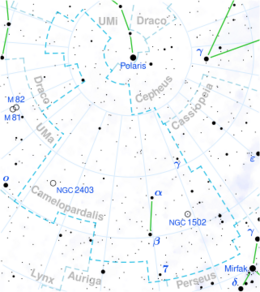Astronomy:HD 28204
HD 28204, also designated as HR 1401, is a spectroscopic binary[16] located in the northern circumpolar constellation Camelopardalis. It has an apparent magnitude of 5.93,[2] making it faintly visible to the naked eye under ideal conditions. Gaia DR3 parallax measurements imply a distance of 331 light-years and it is currently receding with a heliocentric radial velocity of 9 km/s.[5] At its current distance, HD 28204's brightness is diminished by 0.18 magnitudes due to interstellar extinction and it has an absolute magnitude of +0.91.[6]
HD 28204 is a single-lined spectroscopic binary consisting of an Am star and an unseen companion, as the primary is the only one detectable in the spectrum. With a mass of 0.474 M☉,[9] the companion might be a K-type main-sequence star. Both stars take 4.2 days to revolve around each other in a nearly circular orbit, which is somewhat constrained.[7] HD 28204 has two optical companions: a 12th magnitude star located 39" away along a position angle of 257° and a 14th magnitude star located 27.3" along a position angle of 55°.[17]
The visible component has a stellar classification of kA8hF0mF2,[3] indicating that it is an Am star with the calcium K-lines of an A8 star, the hydrogen lines of a F0 star, and the metallic lines of a F2 star. It has 1.68 times the mass of the Sun[9] and an enlarged radius 3.48 times that of the Sun.[10] It radiates 35.7 times the luminosity of the Sun[1] from its photosphere at an effective temperature of 7,320 K,[12] giving it the typical white hue of an A-type star. It is slightly metal deficient with an iron abundance of [Fe/H] = −0.15 or 72% that of the Sun's.[13] Like many Am stars it spins slowly, having a projected rotational velocity of 23 km/s.[3]
References
- ↑ 1.0 1.1 1.2 1.3 1.4 1.5 Vallenari, A. et al. (2022). "Gaia Data Release 3. Summary of the content and survey properties". Astronomy & Astrophysics. doi:10.1051/0004-6361/202243940 Gaia DR3 record for this source at VizieR.
- ↑ 2.0 2.1 Høg, E.; Fabricius, C.; Makarov, V. V.; Urban, S.; Corbin, T.; Wycoff, G.; Bastian, U.; Schwekendiek, P. et al. (March 2000). "The Tycho-2 catalogue of the 2.5 million brightest stars". Astronomy and Astrophysics 355: L27–L30. ISSN 0004-6361. Bibcode: 2000A&A...355L..27H.
- ↑ 3.0 3.1 3.2 3.3 Abt, Helmut A.; Morrell, Nidia I. (July 1995). "The Relation between Rotational Velocities and Spectral Peculiarities among A-Type Stars". The Astrophysical Journal Supplement Series 99: 135. doi:10.1086/192182. ISSN 0067-0049. Bibcode: 1995ApJS...99..135A.
- ↑ 4.0 4.1 Oja, T. (April 1983). "UVB photometry of FK4 and FK4 Supplement stars.". Astronomy and Astrophysics Supplement Series 52: 131–134. ISSN 0365-0138. Bibcode: 1983A&AS...52..131O.
- ↑ 5.0 5.1 Wilson, Ralph Elmer (1953). "General catalogue of stellar radial velocities.". Carnegie Institute Washington D.C. Publication: 0. Bibcode: 1953GCRV..C......0W.
- ↑ 6.0 6.1 Anderson, E.; Francis, Ch. (May 2012). "XHIP: An extended hipparcos compilation". Astronomy Letters 38 (5): 331–346. doi:10.1134/S1063773712050015. ISSN 1063-7737. Bibcode: 2012AstL...38..331A.
- ↑ 7.0 7.1 Luyten, W. J. (1936). "A Rediscussion of the Orbits of Seventy-Seven Spectroscopic Binaries". The Astrophysical Journal (American Astronomical Society) 84: 85. doi:10.1086/143751. ISSN 0004-637X. Bibcode: 1936ApJ....84...85L.
- ↑ 8.0 8.1 Lucy, L. B.; Sweeney, M. A. (August 1971). "Spectroscopic binaries with circular orbits.". The Astronomical Journal (American Astronomical Society) 76: 544. doi:10.1086/111159. ISSN 0004-6256. Bibcode: 1971AJ.....76..544L.
- ↑ 9.0 9.1 9.2 9.3 Kraicheva, Z.; Popova, E.; Tutukov, A.; Yungelson, L. (July 1980). "Catalogue of physical parameters of spectroscopic binary stars.". Bull. Inf. Centre Données Stellaires 19: 71. Bibcode: 1980BICDS..19...71K.
- ↑ 10.0 10.1 Kervella, P.; Thévenin, F.; Di Folco, E.; Ségransan, D. (April 8, 2004). "The angular sizes of dwarf stars and subgiants: Surface brightness relations calibrated by interferometry". Astronomy & Astrophysics 426 (1): 297–307. doi:10.1051/0004-6361:20035930. ISSN 0004-6361. Bibcode: 2004A&A...426..297K.
- ↑ Stassun, Keivan G. et al. (9 September 2019). "The Revised TESS Input Catalog and Candidate Target List". The Astronomical Journal 158 (4): 138. doi:10.3847/1538-3881/ab3467. Bibcode: 2019AJ....158..138S.
- ↑ 12.0 12.1 McDonald, I.; Zijlstra, A. A.; Watson, R. A. (15 June 2017). "Fundamental parameters and infrared excesses of Tycho–Gaia stars". Monthly Notices of the Royal Astronomical Society 471 (1): 770–791. doi:10.1093/mnras/stx1433. ISSN 0035-8711. Bibcode: 2017MNRAS.471..770M.
- ↑ 13.0 13.1 Anders, F. et al. (August 2019). "Photo-astrometric distances, extinctions, and astrophysical parameters for Gaia DR2 stars brighter than G = 18". Astronomy & Astrophysics 628: A94. doi:10.1051/0004-6361/201935765. ISSN 0004-6361. Bibcode: 2019A&A...628A..94A.
- ↑ Gontcharov, G. A. (2012). "Dependence of kinematics on the age of stars in the solar neighborhood". Astronomy Letters 38 (12): 771–782. doi:10.1134/S1063773712120031. Bibcode: 2012AstL...38..771G.
- ↑ "HD 28204". SIMBAD. Centre de données astronomiques de Strasbourg. http://simbad.u-strasbg.fr/simbad/sim-basic?Ident=HD+28204.
- ↑ Pourbaix, D.; Tokovinin, A. A.; Batten, A. H.; Fekel, F. C.; Hartkopf, W. I.; Levato, H.; Morrell, N. I.; Torres, G. et al. (23 August 2004). "SB9: The ninth catalogue of spectroscopic binary orbits". Astronomy & Astrophysics 424 (2): 727–732. doi:10.1051/0004-6361:20041213. ISSN 0004-6361. Bibcode: 2004A&A...424..727P.
- ↑ Mason, Brian D.; Wycoff, Gary L.; Hartkopf, William I.; Douglass, Geoffrey G.; Worley, Charles E. (December 2001). "The 2001 US Naval Observatory Double Star CD-ROM. I. The Washington Double Star Catalog". The Astronomical Journal 122 (6): 3466–3471. doi:10.1086/323920. ISSN 0004-6256. Bibcode: 2001AJ....122.3466M.
 |


